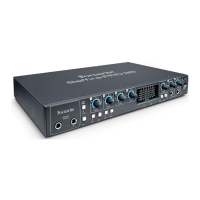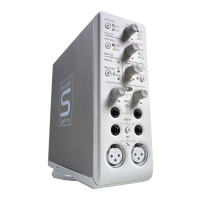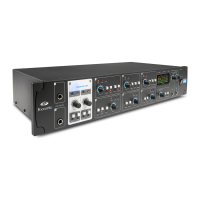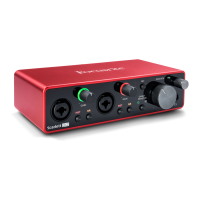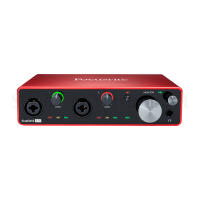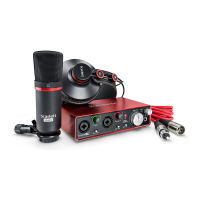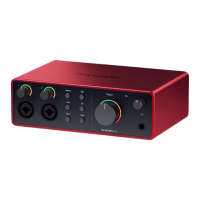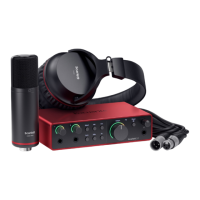Do you have a question about the Focusrite Saffire Pro 24 DSP and is the answer not in the manual?
General safety guidelines for product use, installation, and maintenance.
Warning against exposing the apparatus to rain or moisture to prevent fire or electric shock.
Warning about potential hearing loss from excessive sound pressure levels via earphones.
Cautionary notice regarding risk of electric shock and user-serviceable parts.
Details compliance information and declaration of compliance procedures for the product.
Specific FCC compliance and usage instructions for users in the USA.
Compliance information for users in Canada regarding digital apparatus standards.
Information regarding the product's conformity with RoHS directives and California law.
Introduction to the Saffire PRO 24 DSP and its capabilities as a multi-channel Firewire interface.
Information on accessing additional support resources on the Focusrite website.
Explanation of the Saffire PRO 24 DSP's role in connecting audio signals to a computer.
Description of the Saffire MixControl software for routing, monitoring, and DSP control.
Details on the on-board DSP for compression, EQ, and reverb, including VRM.
List of items included in the Saffire PRO 24 DSP package, such as cables, software, and manuals.
Guidance on connecting the Saffire PRO 24 DSP via FireWire, including cable types and considerations.
Instructions to run the installer before connecting the Saffire PRO 24 DSP to the computer.
Advice on managing FireWire bus bandwidth for optimal performance of the Saffire PRO 24 DSP.
Detailed description and labeling of the input and output connections on the back panel.
Overview of the front panel layout, including input connectors, gain controls, and monitoring controls.
Specifications for Macintosh computers including OS, CPU, memory, and screen resolution.
Specifications for Windows computers including OS, CPU, memory, and screen resolution.
Step-by-step guide for installing the Saffire PRO 24 DSP software on Windows systems.
Instructions on configuring default audio playback and recording devices in Windows.
Step-by-step guide for installing the Saffire PRO 24 DSP software on Mac OS systems.
Instructions on configuring default audio input and output devices in Mac OS.
Information on DAW compatibility with ASIO (Windows) and Core Audio (Mac) drivers.
Guidance on selecting the correct audio driver within your Digital Audio Workstation.
Diagrams illustrating audio signal routing paths at different sample rates and optical configurations.
Routing configuration for 44.1/48kHz sample rate with ADAT optical input.
Routing configuration for 44.1/48kHz sample rate with S/PDIF optical input.
Routing configuration for 88.2/96kHz sample rate with ADAT optical input.
Routing configuration for 88.2/96kHz sample rate with S/PDIF optical input.
Introduction to the Saffire MixControl software for flexible mixing and routing of audio signals.
Instructions on how to open the Saffire MixControl application on Windows and Mac.
Description of the main components of the Saffire MixControl graphical interface.
Guidance on connecting microphones, line, or instrument signals and adjusting preamp settings.
Details on gain settings for inputs 3 and 4, including low/high gain options and clipping levels.
Explanation of the Saffire MixControl software's 8 mixes, channel capabilities, and routing options.
How the mixer section is used for creating custom monitoring mixes for artists and engineers.
How to select different mix tabs within the Saffire MixControl mixer interface.
Detailed description of the components within a mixer input channel, including faders and selectors.
How to select audio sources (inputs and DAW outputs) for mixer channels.
Explanation of the pan slider for positioning audio signals within the stereo field.
How to use the fader to set audio signal levels for monitoring and fine adjustments.
Understanding signal level metering, clip lights, and how to reset them.
Description of Mute, Solo, and Pre-fade Listen (PFL) functions for signal control.
How pressing a button combines two mono channels into one stereo channel.
How to rename tracks in the mixer for better organization.
How to control the overall level of a mix and select output destinations.
Instructions on naming mixes and copying existing mix configurations to other tabs.
Description of the digital signal processing (Compressor and EQ) for analogue inputs 1 and 2.
Detailed explanation of the controls for the compressor effect, including Threshold, Ratio, Attack, Release, and Output.
Explanation of the 4-band EQ controls: Frequency, Gain, Q, and Shelving/High-Pass/Low-Pass switches.
Description of FX chain order, mono/stereo mode, and input/output meters for FX.
How to monitor inputs with or without applied DSP effects in Saffire MixControl.
Setting up routing to record analogue inputs with or without DSP effects using loopback.
Explanation of the reverb controls: REVERB ACTIVE, SIZE, PRE-FILTER, and AIR knobs.
How to set the fader level of the reverb return channel to control reverberation in each mix.
How to set up audio sources to be routed directly to physical outputs.
Description of available audio sources for routing to outputs, including inputs, DAW streams, and mixes.
How routing section selections affect output channel destinations and mix configurations.
Using pre-defined routing presets for quick set-up of various routing and mixer configurations.
Description of specific presets like Clear, DAW Tracking, Zero Latency, Mixing, and Loopback.
Explanation of VRM's purpose: simulating acoustics for headphone reference monitoring.
Description of the three processes involved in VRM: speaker emulation, room modeling, and head-related transfer functions.
Table detailing available listening environments, speaker models, and listening positions.
Data table for listening environments including dimensions, volume, and reverb time.
Data table detailing loudspeaker emulation names, based on models, size, tweeter, woofer, and system.
Navigating the VRM interface, including selecting VRM and understanding the control panel.
Selecting listening environments, positions, and monitor speakers within the VRM system.
Displaying information on environment, listening position, and monitor speakers using the 'i' button.
Explanation of coordinate information like speaker separation, offsets, angles, and distances.
Note on VRM application to headphone output 1 and line outputs 3 & 4, and its suitability for headphones.
Description of controls in the Monitor Section for output levels, mute, dim, and mono.
How the monitor control enable buttons (1-6) indicate which outputs are controlled by the GUI.
Explanation of software and physical monitor knob levels and their effect on outputs.
Description of the three states (Blue, Red, Grey) for monitor control enable buttons.
Using presets for quick changing of typical monitoring set-ups like Stereo, Quad, and Surround.
Diagrams and table for setting up Quad, 2.1, or 5.1 surround sound monitoring.
Diagrams and table for setting up main, mid, and mini loudspeaker configurations.
Detailed descriptions of each monitor preset and their corresponding output assignments.
How to use the monitor level knob to adjust output levels of assigned outputs.
Explanation of the Dim, Mute, Left Mute, and Right Mute switches and their function.
Monitoring sample rate, sync status, and FireWire driver connection for the Saffire PRO 24 DSP.
Setting a unit name and understanding the FireWire driver status when in use.
Setting the format of the optical digital input socket for ADAT or S/PDIF streams.
Enabling AC3 encoded 5.1 audio streaming via S/PDIF outputs.
Adjusting Firewire driver latency settings to affect performance and resolve audio issues.
Ensuring only DAW audio plays through the Saffire PRO 24 DSP on Windows.
Setting the buffer size of the ASIO driver for latency and CPU usage management.
Managing Saffire MixControl set-ups via the File menu: opening, saving, and restoring defaults.
Technical specifications for all analogue input types, including frequency response, gain, and impedance.
Specifications for analogue outputs and overall digital performance, including dynamic range and clocking.
Description of all analogue and digital input connections on the front and rear panels.
Description of analogue and digital output connections, plus FireWire, MIDI, and indicators.
Information on where to find troubleshooting help, directing users to the Focusrite Answerbase.
General safety guidelines for product use, installation, and maintenance.
Warning against exposing the apparatus to rain or moisture to prevent fire or electric shock.
Warning about potential hearing loss from excessive sound pressure levels via earphones.
Cautionary notice regarding risk of electric shock and user-serviceable parts.
Details compliance information and declaration of compliance procedures for the product.
Specific FCC compliance and usage instructions for users in the USA.
Compliance information for users in Canada regarding digital apparatus standards.
Information regarding the product's conformity with RoHS directives and California law.
Introduction to the Saffire PRO 24 DSP and its capabilities as a multi-channel Firewire interface.
Information on accessing additional support resources on the Focusrite website.
Explanation of the Saffire PRO 24 DSP's role in connecting audio signals to a computer.
Description of the Saffire MixControl software for routing, monitoring, and DSP control.
Details on the on-board DSP for compression, EQ, and reverb, including VRM.
List of items included in the Saffire PRO 24 DSP package, such as cables, software, and manuals.
Guidance on connecting the Saffire PRO 24 DSP via FireWire, including cable types and considerations.
Instructions to run the installer before connecting the Saffire PRO 24 DSP to the computer.
Advice on managing FireWire bus bandwidth for optimal performance of the Saffire PRO 24 DSP.
Detailed description and labeling of the input and output connections on the back panel.
Overview of the front panel layout, including input connectors, gain controls, and monitoring controls.
Specifications for Macintosh computers including OS, CPU, memory, and screen resolution.
Specifications for Windows computers including OS, CPU, memory, and screen resolution.
Step-by-step guide for installing the Saffire PRO 24 DSP software on Windows systems.
Instructions on configuring default audio playback and recording devices in Windows.
Step-by-step guide for installing the Saffire PRO 24 DSP software on Mac OS systems.
Instructions on configuring default audio input and output devices in Mac OS.
Information on DAW compatibility with ASIO (Windows) and Core Audio (Mac) drivers.
Guidance on selecting the correct audio driver within your Digital Audio Workstation.
Diagrams illustrating audio signal routing paths at different sample rates and optical configurations.
Routing configuration for 44.1/48kHz sample rate with ADAT optical input.
Routing configuration for 44.1/48kHz sample rate with S/PDIF optical input.
Routing configuration for 88.2/96kHz sample rate with ADAT optical input.
Routing configuration for 88.2/96kHz sample rate with S/PDIF optical input.
Introduction to the Saffire MixControl software for flexible mixing and routing of audio signals.
Instructions on how to open the Saffire MixControl application on Windows and Mac.
Description of the main components of the Saffire MixControl graphical interface.
Guidance on connecting microphones, line, or instrument signals and adjusting preamp settings.
Details on gain settings for inputs 3 and 4, including low/high gain options and clipping levels.
Explanation of the Saffire MixControl software's 8 mixes, channel capabilities, and routing options.
How the mixer section is used for creating custom monitoring mixes for artists and engineers.
How to select different mix tabs within the Saffire MixControl mixer interface.
Detailed description of the components within a mixer input channel, including faders and selectors.
How to select audio sources (inputs and DAW outputs) for mixer channels.
Explanation of the pan slider for positioning audio signals within the stereo field.
How to use the fader to set audio signal levels for monitoring and fine adjustments.
Understanding signal level metering, clip lights, and how to reset them.
Description of Mute, Solo, and Pre-fade Listen (PFL) functions for signal control.
How pressing a button combines two mono channels into one stereo channel.
How to rename tracks in the mixer for better organization.
How to control the overall level of a mix and select output destinations.
Instructions on naming mixes and copying existing mix configurations to other tabs.
Description of the digital signal processing (Compressor and EQ) for analogue inputs 1 and 2.
Detailed explanation of the controls for the compressor effect, including Threshold, Ratio, Attack, Release, and Output.
Explanation of the 4-band EQ controls: Frequency, Gain, Q, and Shelving/High-Pass/Low-Pass switches.
Description of FX chain order, mono/stereo mode, and input/output meters for FX.
How to monitor inputs with or without applied DSP effects in Saffire MixControl.
Setting up routing to record analogue inputs with or without DSP effects using loopback.
Explanation of the reverb controls: REVERB ACTIVE, SIZE, PRE-FILTER, and AIR knobs.
How to set the fader level of the reverb return channel to control reverberation in each mix.
How to set up audio sources to be routed directly to physical outputs.
Description of available audio sources for routing to outputs, including inputs, DAW streams, and mixes.
How routing section selections affect output channel destinations and mix configurations.
Using pre-defined routing presets for quick set-up of various routing and mixer configurations.
Description of specific presets like Clear, DAW Tracking, Zero Latency, Mixing, and Loopback.
Explanation of VRM's purpose: simulating acoustics for headphone reference monitoring.
Description of the three processes involved in VRM: speaker emulation, room modeling, and head-related transfer functions.
Table detailing available listening environments, speaker models, and listening positions.
Data table for listening environments including dimensions, volume, and reverb time.
Data table detailing loudspeaker emulation names, based on models, size, tweeter, woofer, and system.
Navigating the VRM interface, including selecting VRM and understanding the control panel.
Selecting listening environments, positions, and monitor speakers within the VRM system.
Displaying information on environment, listening position, and monitor speakers using the 'i' button.
Explanation of coordinate information like speaker separation, offsets, angles, and distances.
Note on VRM application to headphone output 1 and line outputs 3 & 4, and its suitability for headphones.
Description of controls in the Monitor Section for output levels, mute, dim, and mono.
How the monitor control enable buttons (1-6) indicate which outputs are controlled by the GUI.
Explanation of software and physical monitor knob levels and their effect on outputs.
Description of the three states (Blue, Red, Grey) for monitor control enable buttons.
Using presets for quick changing of typical monitoring set-ups like Stereo, Quad, and Surround.
Diagrams and table for setting up Quad, 2.1, or 5.1 surround sound monitoring.
Diagrams and table for setting up main, mid, and mini loudspeaker configurations.
Detailed descriptions of each monitor preset and their corresponding output assignments.
How to use the monitor level knob to adjust output levels of assigned outputs.
Explanation of the Dim, Mute, Left Mute, and Right Mute switches and their function.
Monitoring sample rate, sync status, and FireWire driver connection for the Saffire PRO 24 DSP.
Setting a unit name and understanding the FireWire driver status when in use.
Setting the format of the optical digital input socket for ADAT or S/PDIF streams.
Enabling AC3 encoded 5.1 audio streaming via S/PDIF outputs.
Adjusting Firewire driver latency settings to affect performance and resolve audio issues.
Ensuring only DAW audio plays through the Saffire PRO 24 DSP on Windows.
Setting the buffer size of the ASIO driver for latency and CPU usage management.
Managing Saffire MixControl set-ups via the File menu: opening, saving, and restoring defaults.
Technical specifications for all analogue input types, including frequency response, gain, and impedance.
Specifications for analogue outputs and overall digital performance, including dynamic range and clocking.
Description of all analogue and digital input connections on the front and rear panels.
Description of analogue and digital output connections, plus FireWire, MIDI, and indicators.
Information on where to find troubleshooting help, directing users to the Focusrite Answerbase.
| Interface Type | FireWire |
|---|---|
| Number of Preamps | 2 |
| Analog Inputs | 4 |
| Headphone Outputs | 2 |
| Bit Depth | 24-bit |
| Phantom Power | Yes |
| DSP Effects | Yes |
| Computer Connection | FireWire |
| DSP Processing | Yes |
| Software Included | Saffire MixControl |
| Digital Inputs | S/PDIF |
| Digital Outputs | S/PDIF |
| Sample Rate | 44.1 kHz, 48 kHz, 88.2 kHz, 96 kHz |
| MIDI I/O | Yes |
| Analog Inputs Detail | 2 x XLR/TRS combo |
| FireWire | Yes |
| Analog Outputs Detail | 6 x TRS |
| Weight | 1.6 kg |
